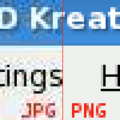Lossy compression
Lossy compression is a form of data compression where parts of the data are lost in the process.[1] When a compressed data is returned to normal some data is lost. Lossy compression is used to greatly reduce the size of a computer file when it is stored, handled, or transmitted. As an example, JPEG is a lossy compression format.[2] GIF and PNG are lossless compression systems.[2] Other lossy compression systems are MP3 for sound files and WMV for video. If a file were to be compressed too much, it would cause the file to be noticeably lower in quality.
